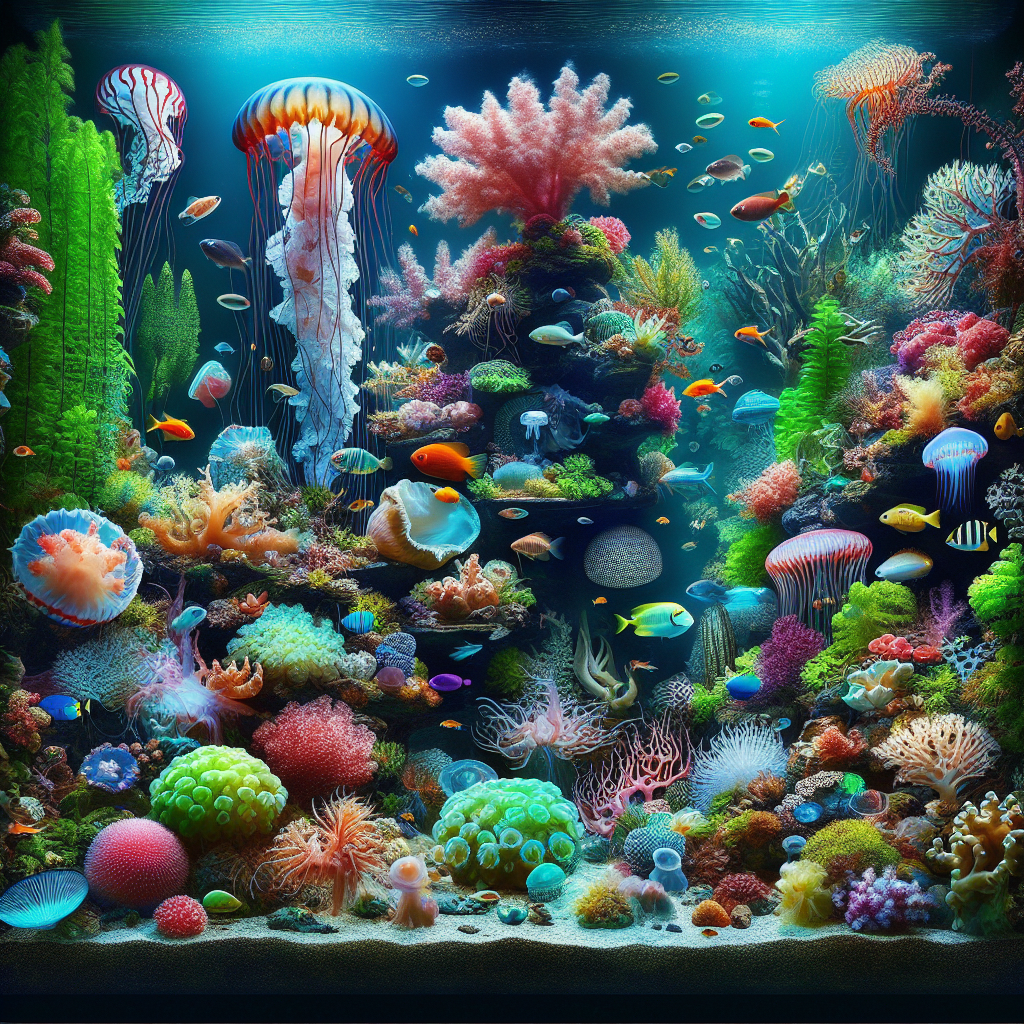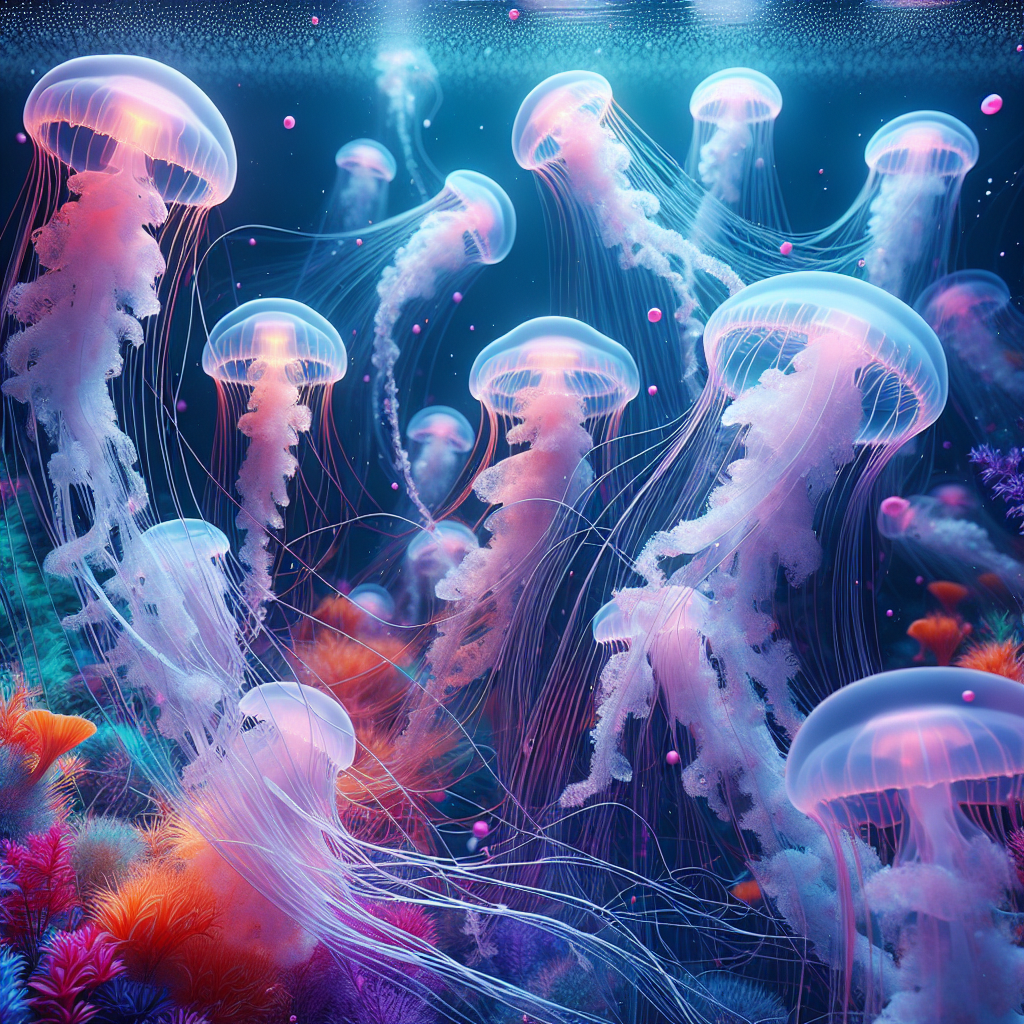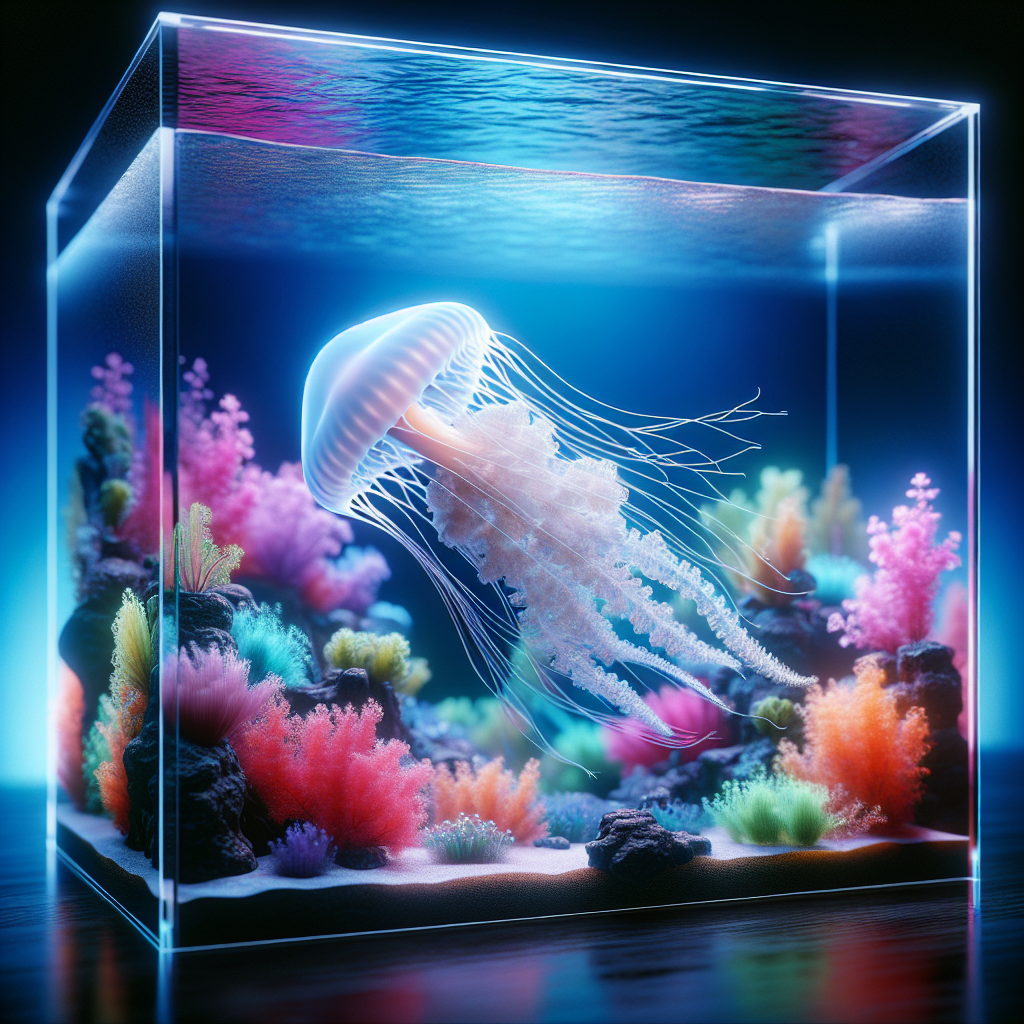A Guide to Saltwater Aquariums for Pet Fish and Mesmerizing Jellyfish
In the vibrant realm of aquatic life, few experiences rival the allure of a meticulously curated saltwater aquarium. These captivating ecosystems offer a window into the colorful and diverse world beneath the waves, where both pet fish and the ethereal jellyfish can be showcased in all their splendor. As more enthusiasts are drawn to the beauty of marine habitats, the art of crafting these thriving underwater worlds has become a rewarding hobby and a fascinating journey.
Creating a saltwater aquarium is an opportunity to blend science with artistry, requiring a delicate balance of elements to simulate enchanting marine environments. From selecting the right species to understanding the critical parameters of water chemistry, each step is crucial in ensuring the health and vitality of your aquatic inhabitants. The process demands an appreciation for the intricate dance of life, where symbiosis and homeostasis play pivotal roles.
Whether you’re captivated by the playful antics of clownfish or the mesmerizing movements of jellyfish, this guide will navigate you through the essentials of designing and maintaining a saltwater aquarium. Embrace the wonders of marine life and transform your space into a sanctuary of aquatic wonderment, where every glance reveals a new discovery.
Choosing the Right Saltwater Aquarium for Your Home

Transforming a corner of your home into a mesmerizing marine paradise begins with selecting the ideal saltwater aquarium. This decision hinges on various factors, including space, budget, and the types of marine life you wish to nurture. Each aquarium tells its own story, offering a unique glimpse into the wonders of the ocean. Let’s delve into the essentials of choosing the perfect setup for your living space.
Understanding Saltwater Aquarium Types
Before venturing into the vibrant world of marine aquariums, it’s crucial to understand the different types available. Each type serves distinct purposes and caters to various preferences, from showcasing colorful coral reefs to highlighting the elegant simplicity of jellyfish.
Reef Tanks are a popular choice among aquarists captivated by the intricate beauty of corals. These aquariums require careful attention to lighting and water chemistry, as they simulate the natural habitat of coral reefs. A well-maintained reef tank can become a breathtaking centerpiece, teeming with life and color.
For those enchanted by the gentle, rhythmic movements of jellyfish, a jellyfish aquarium is an excellent choice. These specialized tanks are designed to accommodate the unique needs of jellyfish, providing a gentle water flow and a round, flow-friendly design to prevent injury to these delicate creatures.
Alternatively, if you’re interested in a more general approach, a fish-only saltwater aquarium might be the way to go. These setups focus primarily on fish species, making them easier to maintain compared to reef tanks. They offer a diverse array of vibrant marine life without the added complexity of coral care.
Essential Equipment and Accessories
With your chosen aquarium type, equipping it with the right tools is the next step. The success of your saltwater aquarium largely depends on having the appropriate equipment to maintain a stable and healthy environment for your aquatic inhabitants.
A high-quality filtration system is indispensable, ensuring that water quality remains optimal by removing waste and toxins, vital for the well-being of both fish and corals. Protein skimmers are often recommended as they help remove organic compounds before they break down.
Lighting is another critical component, especially for reef tanks. Photosynthesis is essential for coral health, and the right lighting system can mimic the natural sunlight found in coral habitats. LED lights are a popular choice due to their energy efficiency and customizable settings.
Temperature regulation is key, with heaters and chillers maintaining a consistent temperature that mimics natural marine conditions. An aquarium thermometer will help monitor this to prevent any sudden fluctuations that could stress your marine life.
- Filtration System
- Lighting
- Temperature Regulation
- Protein Skimmer
Lastly, don’t forget about water pumps and powerheads, which enhance the circulation of water within the tank. This movement is crucial for oxygenation and distributing nutrients throughout the ecosystem.
Setting Up Your Saltwater Aquarium
With the right aquarium and equipment in hand, the next step is setting up the environment where your marine life will thrive. Patience is a virtue here, as rushing the process can lead to imbalances that affect the health of your aquatic inhabitants.
Begin by choosing the location of your aquarium. It should be placed away from direct sunlight to prevent overheating and algae growth while also being easily accessible for maintenance. Consider the weight of a filled aquarium, ensuring your chosen spot can support it safely.
Next, it’s time to prepare the water. Saltwater aquariums require a specific mix of water and marine salt, which needs to be cycled properly before introducing any life forms. Cycling establishes beneficial bacteria that are essential for breaking down waste and maintaining water quality.
Adding live rock and substrate enhances the aesthetic appeal of your aquarium and plays a functional role in maintaining water chemistry. Live rock provides a habitat for beneficial bacteria, while the substrate can influence pH levels and serve as a base for corals and plants.
Finally, introduce your chosen marine life gradually. Start with hardy species that can withstand initial fluctuations in water parameters. As your tank stabilizes, you can introduce more sensitive species, ensuring a harmonious and balanced ecosystem.
“The sea, once it casts its spell, holds one in its net of wonder forever.” – Jacques Yves Cousteau
Setting up a saltwater aquarium is a journey of discovery and reward. With the right choices and a careful approach, you’ll create a thriving underwater world that captivates and inspires all who gaze upon it.
Creating a Balanced Ecosystem for Pet Fish

Imagine a world where vibrant fish glide gracefully through crystal-clear waters, each species contributing to a harmonious aquatic ballet. Achieving this captivating vision requires more than just setting up a tank; it involves cultivating a balanced ecosystem tailored to the needs of your pet fish. By carefully selecting suitable fish species and managing water quality, you can create a thriving marine environment that mirrors the ocean’s natural beauty.
Selecting Suitable Fish Species
Choosing the right fish species for your saltwater aquarium is pivotal in establishing a harmonious underwater community. Each species has unique behavioral traits and environmental needs, so understanding these characteristics is crucial. Begin by researching the compatibility of various fish, considering their size, temperament, and habitat requirements.
When selecting fish, consider opting for hardy species that can adapt to the fluctuating conditions of a newly established tank. Popular choices include clownfish, damselfish, and gobies, known for their resilience and vibrant colors. Avoid overcrowding the tank, as this can lead to stress and aggression among the fish. A general rule of thumb is to allow one inch of fish per every two to three gallons of water.
Additionally, consider the role of each species within the ecosystem. Some fish, like tangs and wrasses, act as natural algae grazers, helping to maintain the tank’s cleanliness. Others, such as certain species of shrimp or snails, can serve as scavengers, consuming leftover food and detritus. By incorporating a diverse array of species, you can replicate the complex interactions found in natural marine habitats.
Managing Water Quality and Conditions
Once you’ve selected your fish, maintaining optimal water quality is essential for their health and well-being. Water quality affects fish behavior, growth, and overall health, making it a cornerstone of successful aquarium management. Regular testing and monitoring are vital to ensure stability in the aquatic environment.
Maintaining Salinity and Temperature
Salinity and temperature are two critical parameters that must be meticulously controlled. Most marine fish thrive in a salinity range of 1.020 to 1.025 specific gravity. Salinity levels can be measured using a hydrometer or refractometer, and adjustments can be made by adding fresh or saltwater as needed. Maintaining consistency is important, as sudden changes can stress fish and lead to disease.
Temperature is another vital factor, with most saltwater species preferring a range between 75°F and 82°F. Use an aquarium heater and thermometer to monitor and maintain this range. Sudden temperature fluctuations can compromise the immune systems of your fish, leaving them vulnerable to illness. A reliable heater with a built-in thermostat can prevent these fluctuations, providing a stable environment for your aquatic inhabitants.
Feeding and Care Routines
Feeding your pet fish involves more than just offering food; it requires understanding their dietary needs and establishing a consistent care routine. Fish have unique nutritional requirements, and providing a balanced diet is crucial to their health and longevity.
Research the dietary preferences of the fish species you’ve chosen and provide various foods, including flakes, pellets, and frozen or live foods. For instance, omnivorous fish like clownfish benefit from a mix of protein-rich foods and algae-based products. Feed your fish small amounts multiple times a day, ensuring all food is consumed to prevent waste accumulation, which can degrade water quality.
In addition to feeding, regular maintenance is key to sustaining a healthy aquarium. Schedule routine tasks such as water changes, filter cleanings, and equipment inspections. These practices help prevent the buildup of harmful substances and ensure a pristine environment for your fish. Observing your fish daily can also alert you to any signs of illness or stress, allowing for prompt intervention.
“The beauty of the sea lies not only in its vastness but in the delicate balance of its ecosystems.” – Sylvia Earle
Crafting a balanced ecosystem within a saltwater aquarium is both an art and a science. By carefully selecting compatible fish species, maintaining precise water conditions, and adhering to a thoughtful feeding regimen, you can create a mesmerizing aquatic world that flourishes with life. This diligent attention to detail transforms your aquarium into a living masterpiece, captivating all who behold its beauty.
Mesmerizing Jellyfish Displays: A Unique Aquarium Experience

Have you ever been captivated by the delicate dance of jellyfish in an aquarium, their translucent bodies gliding effortlessly through the water? These ethereal creatures provide a serene and mesmerizing experience that sets them apart from typical marine displays. Creating a jellyfish aquarium is both a unique endeavor and a rewarding challenge, offering a closer look at one of the ocean’s most fascinating inhabitants. Let’s explore how to bring this enchanting experience into your own home.
Choosing the Right Jellyfish Species
Before diving into the world of jellyfish aquariums, it’s essential to understand the various species available and their specific needs. Not all jellyfish are suitable for home aquariums; therefore, selecting the right species is crucial to ensuring a successful setup. The species you choose will influence the tank design, lighting, and maintenance routine.
Some popular options for home aquariums include the Moon Jellyfish (Aurelia aurita), known for their gentle pulsations and translucent beauty. These jellyfish are relatively hardy and adapt well to captive environments, making them ideal for beginners. Another option is the Upside-Down Jellyfish (Cassiopea), which is unique for its inverted swimming style and symbiotic algae that give it a distinct appearance.
When choosing a species, consider their size, dietary requirements, and compatibility with other marine life. It’s advisable to start with a single species tank to avoid competition and ensure a stable environment. Researching the specific needs of your chosen jellyfish will help you tailor your aquarium to their requirements.
Specialized Equipment for Jellyfish Tanks
Creating a suitable environment for jellyfish requires specialized equipment designed to accommodate their unique physiology. Unlike traditional aquariums, jellyfish tanks must address the delicate nature of these creatures, preventing injury and ensuring their well-being.
The centerpiece of a jellyfish aquarium is the kreisel tank, a circular or oval-shaped design that promotes a gentle flow of water. This design prevents jellyfish from getting trapped in corners and ensures they remain suspended in the water column. The tank’s construction is crucial in mimicking the open water conditions jellyfish thrive in.
Lighting plays a pivotal role in showcasing the ethereal beauty of jellyfish. LED lights with adjustable color settings can enhance the natural glow of jellyfish, highlighting their translucent bodies. However, it’s essential to provide a lighting environment that does not stress the jellyfish. Intensity and duration should be monitored to prevent any adverse effects on their health.
Filtration systems in jellyfish tanks differ from those in standard aquariums. A gentle filtration system that avoids strong currents is vital, as jellyfish can easily become entangled in traditional filters. Sponge filters or custom-designed filtration systems are often recommended to maintain water quality without risking harm to the jellyfish.
Ensuring a Healthy Environment for Jellyfish
Maintaining a healthy environment for jellyfish involves more than just the right tank and equipment. It requires diligent monitoring and care to ensure that all conditions support the well-being of these delicate creatures. Water quality, temperature, and nutrition are all essential components of a thriving jellyfish aquarium.
Water quality is paramount, as jellyfish are highly sensitive to changes in their environment. Regular testing of water parameters such as ammonia, nitrites, and nitrates is necessary to maintain optimal conditions. A stable pH level between 7.6 and 8.4 is generally recommended. Consistent water changes and careful monitoring can prevent the accumulation of harmful substances.
Temperature regulation is equally important, with most jellyfish species thriving in a range of 75°F to 80°F. Using a reliable heater and thermometer ensures that the temperature remains consistent, safeguarding the jellyfish from stress-related issues. Avoiding sudden fluctuations is crucial, as even minor changes can have significant impacts on their health.
Proper nutrition is another critical aspect of jellyfish care. They primarily feed on small planktonic organisms, which can be replicated in captivity with specially formulated jellyfish food or live brine shrimp. Feeding should occur regularly, but overfeeding should be avoided to prevent water quality degradation. Observing their feeding behavior can also offer insights into their overall health.
“In the end, we will conserve only what we love; we will love only what we understand; and we will understand only what we are taught.” – Baba Dioum
Creating a jellyfish aquarium provides a unique opportunity to connect with one of nature’s most captivating creatures. By selecting the right species, utilizing specialized equipment, and maintaining a healthy environment, you can enjoy the tranquil beauty of jellyfish while ensuring their well-being. This delicate balance of care and technology transforms a simple aquarium into a window to the ocean’s wonders, offering a serene escape into the captivating world beneath the waves.
Embracing the Wonders of the Ocean in Your Home
Creating a thriving underwater world in your home is as enriching as the vibrant life it supports. From selecting the right aquarium type to equipping it with essential tools, every decision shapes a miniature ocean ecosystem. Whether your fascination lies in the dynamic dance of pet fish or the ethereal glide of jellyfish, understanding their unique needs is vital.
Crafting a balanced habitat involves more than just aesthetic appeal—it demands a harmonious blend of art and science. By choosing suitable species, maintaining precise water chemistry, and implementing regular care routines, your aquarium can mirror the ocean’s natural splendor. Meanwhile, jellyfish aquariums present a unique challenge, requiring specialized equipment and diligent monitoring to ensure these delicate creatures thrive.
Ultimately, the reward is a mesmerizing display of marine life that captivates and inspires. Your saltwater aquarium becomes a testament to the beauty of the ocean, a personal sanctuary where each glance reveals new wonders. In this peaceful aquatic realm, you connect with the ocean’s mysteries, fostering a deeper appreciation for the delicate balance of nature.